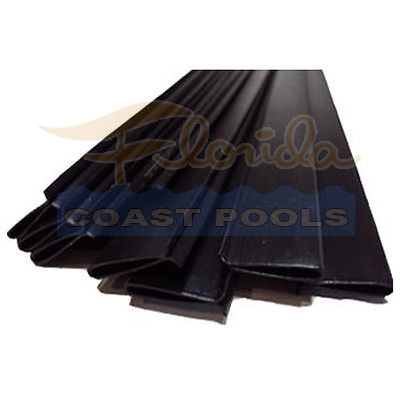Above Ground Pool Liner Coping
For all the do it yourself pool liner installers out there this blog is a great read. I was inspired to write it by a pool liner replacement we recently did in Deltona where the home owners gave up on doing the liner change themselves. They built the pool originally and did a very nice job doing so, but a change in liner design derailed their valiant efforts. If a self installed pool liner change is in your future, reading this blog may prove to be quite valuable one day.
What Is Pool Liner Coping For Above Ground Pools?
Pool liner coping simply installs on top of the pool liner and holds it firmly onto the pool wall. Liner coping is needed to hold the liner in place while protecting it from being damaged by the metal stabilizer bars. The metal or sometimes resin stabilizer bars squeeze the coping ensuring a tight grip on the pool liner preventing it from slipping off the pool wall and down in the water. Coping is always made of plastic and comes in strips that vary between 2 and four feet in length. The shape of the coping can vary but it’s mostly flat or V-shaped like the image above.
Liner Coping And Different Style Liners
Today most all above ground pool kits come with either an overlap or unibead pool liner. The unibead liner is considered an upgrade because they are a fitted liner and designed for a specific pool wall height. When purchasing one you must know the height of the pool wall for proper fit. The reason for upgrading to the unibead or J-Hook pool liner is they are more decorative, easier to install and have the coping built into their design.
Because the upper lip of the the unibead/j-hook liner is so thick no additional coping is used. The extra cost of this type of liner is usually offset by the fact no coping needs to be purchased for it’s installation. This usually makes this type of liner the better way to go for most self installers.
Now back to our frustrated home owner I told you about in the beginning of this blog post. When these nice people first bought their pool it came with the unibead or j-hook pool liner to start with. After several years of use it was time for them to replace it, so they purchased a new overlap liner to save some money. Once the pool was disassembled and readied for the new liner the problems began as overlap liners require coping strips to keep the liner attached at the top of the pool wall and their pool had none to begin with. So after many days of trying to keep the liner on the wall, filling and emptying the pool several time, they finally gave up the fight. Luckily for them the liner wasn’t ruined in the process, but could have been if they went much further.
If they had only known that pool liner coping is required on all overlap liners they may had gotten through this project successfully. Just remember that all overlap pool liner need coping strips to secure it to the wall and they should be replaced when changing the pool liner every time. If you always buy a coping kit for your size pool you’ll never have an issue similar to this. Pool liner coping kits aren’t expensive and they’re great insurance that your liner installation will be a better one.



